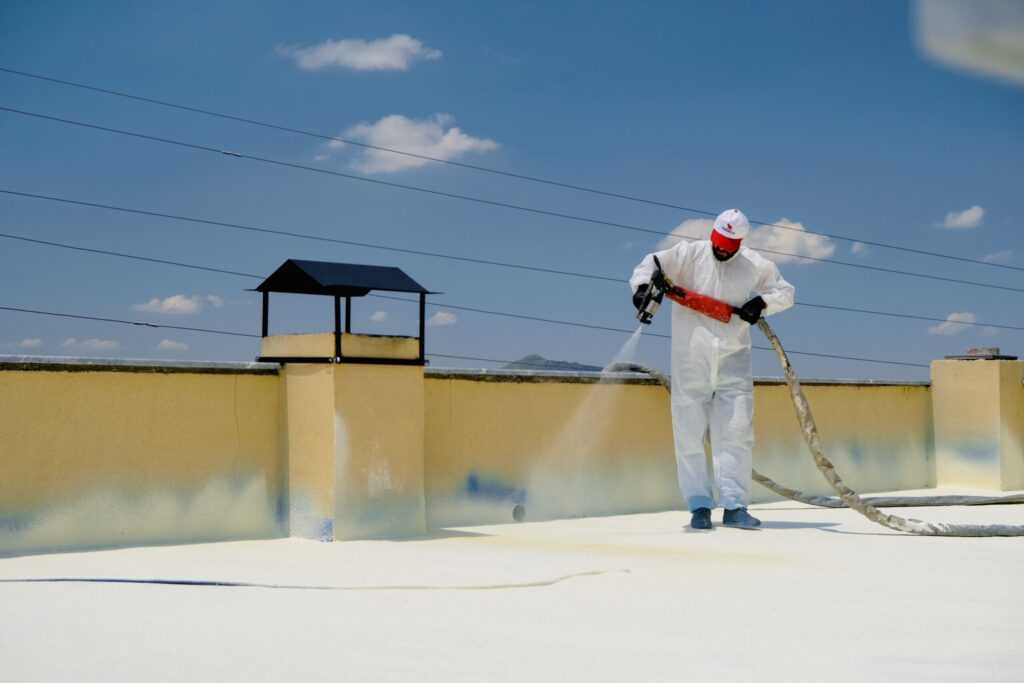When you think of someone installing a new roof on your business, it is unlikely that you are imagining them using a spray solution. Spray foam roofing is not the most popular type of roofing, so you may have never heard of it. However, this spray-on roofing system could be just what you need for your building.
What Is Spray Foam Roofing?
Spray Polyurethane Foam (SPF) roofing is a spray foam that is used to waterproof various roofing surfaces. The foam is created by two materials, isocyanate, and polyol resin. When combined, the two create a foam that expands up to 30-60 times its liquid volume. Although SPF roofing has been around for many years, it is still widely unknown to many property owners. This lightweight, durable roofing material has been used in commercial and industrial applications since the 1960s.
Spray foam roofs are either closed-cell or open-cell. Closed-cell foam is comprised of cells that are closed, as the name suggests. The cells are so tightly packed that they do not allow air and water to enter. On the other hand, open-cell foam has cells that are open. This causes them to be less dense and softer to the touch. Closed-cell foam is usually used for roofing, while open-cell foam is used to insulate the interior of a building.
How Is Spray Foam Roofing Installed?
Spray Foam is installed directly over the existing roofing, making it a quick and easy process. This is ideal for buildings such as apartments, hospitals, and other businesses that operate 24/7.
Before spray foam roofing is applied, the previous roof should be cleared of dirt and debris. During installation, the spray foam is applied to the surface in its liquid form. Once it is exposed to oxygen, the liquid turns into a foam that then hardens, leaving a solid, durable coating over the roof. Finally, a silicone protective layer is applied. This layer protects the roof from UV rays and lowers heat absorption.
Spray Foam Roofing is a delicate chemical reaction. As a result, it can only be installed under certain conditions. It is recommended that the temperature is at least 50 degrees Fahrenheit so that the roofing is installed properly.
Can Spray Foam Roofing Be Applied to Your Roof?
Spray foam roofing is most commonly used on flat roofs or roofs with a moderately low slope. Some examples of these roofs are:
- Metal Roofs
- Thermoplastic Polyolefin (TPO) Roofs
- Ethylene Propylene Diene Terpolymer (EPDM) Roofing
Foam is perfect for such surfaces as it fills in the tiniest cracks and does not allow rain and moisture to permeate the roof itself. Although it is commonly used on flat and mildly sloped roofs, it can also be used on any roofing system.
You might consider spray foam roofing if your business is new construction, you have a roof with solar panels installed, or you own a building in the commercial, industrial, or manufacturing industries. These types of buildings would not benefit from loud construction sounds from other types of roof repairs.
Benefits of Spray Foam Roofing
Quick Installation
The installation process for spray foam roofing is fairly quick compared to other roofing solutions. Additionally, it is not a loud process. The addition of the foam throughout the roof is not disruptive to the operations of the building. After removing the dust and debris from the current roof, the spray foam can be applied, then finished with a protective coat. The ease of the installation saves building owners both time and money in the process.
Durability
Spray foam roofing is commonly known for its long lifespan. With proper maintenance, a spray foam roof can last up to fifty years. Although spray foam roofing is lightweight, it is still very protective of the foundation of the building. It respects the structural integrity of the space and allows it to last longer.
Energy Efficiency
Spray foam roofing can reduce cooling expenses by up to 30% because the material absorbs the sun\’s ultraviolet rays. Because of this, the building will stay cooler during the warmer months and allow for less use of the air conditioner.
This roofing solution can also be considered environmentally friendly because it does not create much excess waste. Other roof repairs can require tearing out the existing roof, therefore, creating waste in the process.
Cost
On average, a spray foam roof costs $3.50 to $7 per square foot, depending on the location, roof conditions, and foam thickness. Comparable to other roofing materials, spray foam roofing lands on the cheaper side. In the long run, the money that you save on your energy bill when using this material will measure up to the amount you will spend on maintenance costs.
Maintenance
Once the foam is applied, maintenance is considerably easy. The spray foam roof can almost be forgotten about without worry. Proper preventative maintenance encourages semi-annual tests. However, the maintenance is almost non-existent.
Additionally, repairing the old foam installation is not hard. There is no need to remove the old insulation. The process is as simple as spraying over the previous application.
R-Value
R-value refers to the ability of a building’s insulation to prevent the flow of heat in and out of a building. A major advantage of spray foam roofing is that it has a very high r-value. This means that the building will stay cool during the summer and warm during the winter.
Best Spray Foam Roofing in Madison, WI
Yutzy Roofing Service is the leading choice for spray foam roofing in Madison, WI. Since 1995, we\’ve been providing high-quality spray foam roofing services that keep your buildings safe, secure, and leak-free. Don\’t let a leaky roof get in the way of your business operations. Our team of trained professionals is determined to provide the best roofing solutions for your needs. We are licensed, insured, and bonded. Call Yutzy Roofing Service today for your next spray foam roofing services in Madison, WI, or a neighboring area.

